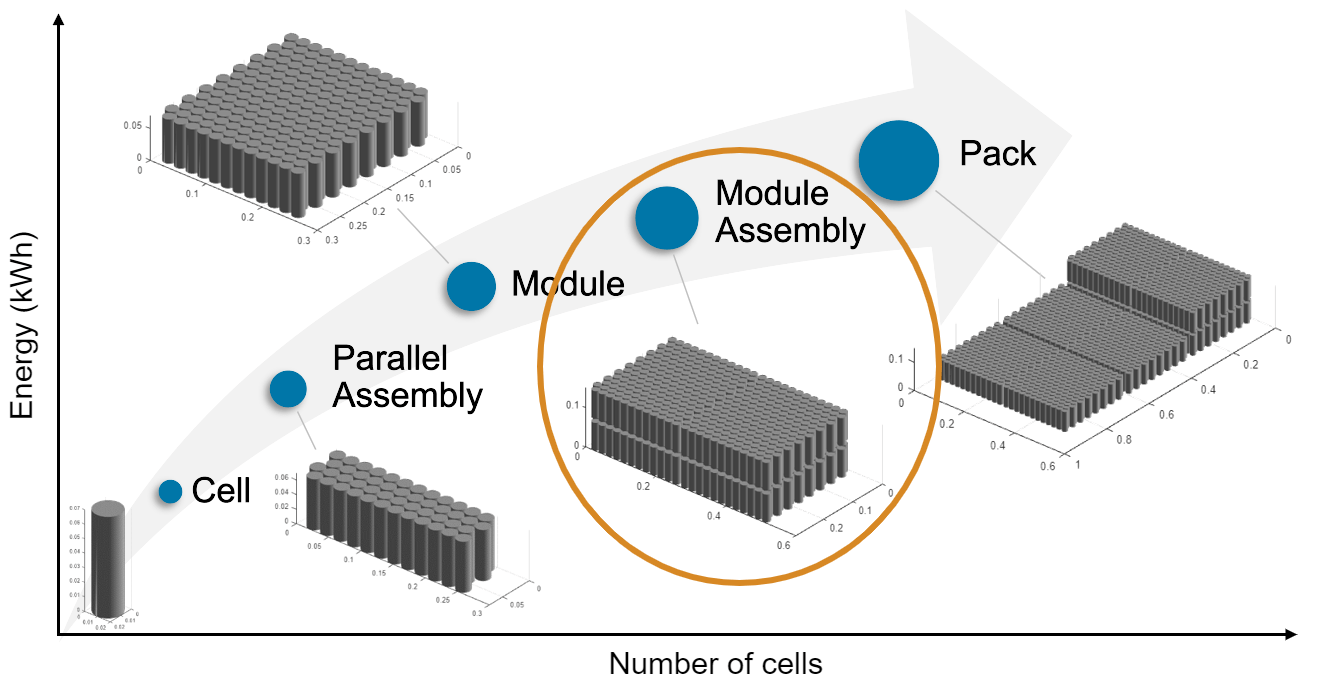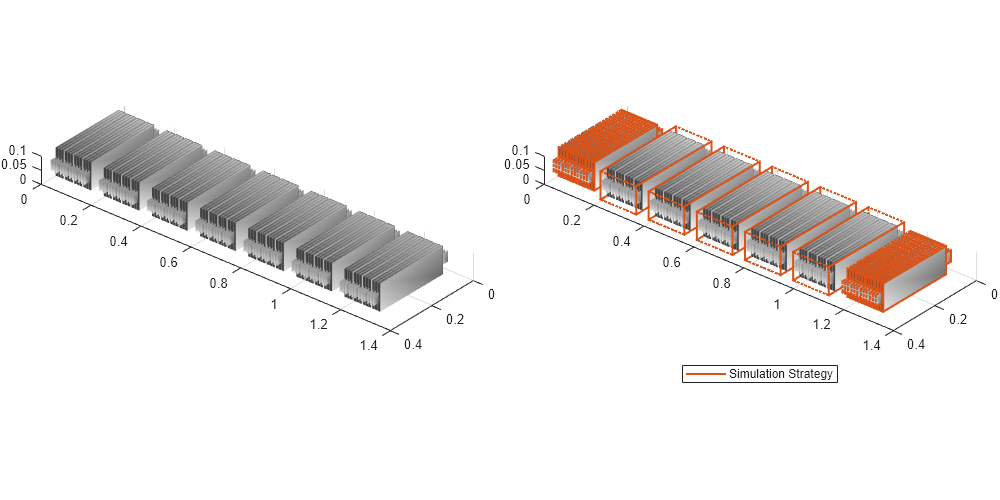Build Model of Battery Module Assembly with Multi-Module Cooling Plate
This example shows how to create and build a Simscape™ system model of a module assembly with a multi-module cooling plate by using Simscape™ Battery™. Large cooling plates that span across several battery modules are quite common in the design of battery systems, including in the automotive and consumer electronics sector. The workflow in this example automates the process of thermally coupling several modules together to a single battery cooling plate. To create the system model of a battery ModuleAssembly, you must first create the Cell, ParallelAssembly, and Module objects that comprise the battery module assembly, and then use the buildBattery function. The buildBattery function generates Simscape models for these Simscape Battery objects:
This function creates a library in your working folder that contains a system model block of a battery module. Use this model as reference in your simulations. You can modify the run-time parameters for this model block, such as the battery cell resistance or the battery open-circuit voltage, after you create the model. To define the run-time parameters, specify them in the block mask of the generated Simscape models or use the MaskParameters argument of the buildBattery function.
Create Battery ModuleAssembly Object in MATLAB
To create a battery module assembly object, you must first design and create the foundational elements of the battery module assembly.
This figure shows the hierarchy of a battery pack object in a bottom-up view:

A battery module assembly comprises multiple battery modules. These module assemblies, in turn, comprise a number of battery parallel assemblies connected electrically in parallel or series under a specific topological configuration or geometrical arrangement.
Create Cell Object
To create the ModuleAssembly object, first create a Cell object with the pouch geometry.
The PouchGeometry object defines the pouch geometrical arrangement of the battery cell. To create the PouchGeometry object, use the batteryPouchGeometry function. Specify the cell height as the first argument, the cell length as the second argument, and the tab location with the name-value argument TabLocation.
pouchGeometry = batteryPouchGeometry(simscape.Value(0.1,"m"),... simscape.Value(0.3,"m"),TabLocation="Opposed");
Now use this PouchGeometry object to create a pouch battery cell.
pouchCell = batteryCell(pouchGeometry)
pouchCell =
Cell with properties:
Geometry: [1×1 simscape.battery.builder.PouchGeometry]
CellModelOptions: [1×1 simscape.battery.builder.CellModelBlock]
Mass: 0.1000 (kg)
Capacity: 5 (A*hr)
Energy: 50 (W*hr)
Show all properties
The Cell object allows you to simulate the thermal effects of the battery cell by using a simple 1-D model. To simulate the thermal effects of the battery cell, in the BlockParameters property of the CellModelOptions property of the Cell object, set the thermal_port property to "model" and the T_dependence property to "yes".
pouchCell.CellModelOptions.BlockParameters.thermal_port = "model"; pouchCell.CellModelOptions.BlockParameters.T_dependence = "yes";
You can define the thermal boundary conditions for battery parallel assemblies and modules only if you have previously defined a thermal model at the cell level.
Create ParallelAssembly Object
A parallel assembly comprises multiple battery cells connected electrically in parallel under a specific topological configuration or geometrical arrangement. In this example, you create a parallel assembly of three pouch cells.
To create the ParallelAssembly object, use the batteryParallelAssembly function. Define the Cell object as the first argument and the number of cells in parallel as the second argument. To specify the model resolution, use the name-value argument ModelResolution.
parallelAssembly = batteryParallelAssembly(pouchCell,3,... ModelResolution="Detailed");
Create Module Object
A battery module comprises multiple parallel assemblies connected in series. In this example, you create a battery module of four parallel assemblies, with a gap between each parallel assembly of 0.005 meters, and a lumped model resolution. You also create another Module object with a detailed model resolution.
To create these Module objects, use the batteryModule function. Define the ParallelAssembly object as the first argument and the number of parallel assemblies in series as the second argument. To specify the additional properties, use the name-value arguments InterParallelAssemblyGap and ModelResolution.
lumpedModule = batteryModule(parallelAssembly,4,... InterParallelAssemblyGap=simscape.Value(0.005,"m")); detailedModule = batteryModule(parallelAssembly,4,... InterParallelAssemblyGap=simscape.Value(0.005,"m"), ... ModelResolution="Detailed");
Create ModuleAssembly Object
A battery module assembly comprises multiple battery modules connected in series or in parallel. In this example, you create a battery module assembly of three different modules, with a gap between each module of 0.01 meters. By default, the ModuleAssembly object electrically connects the modules in series.
To create the ModuleAssembly object, use the batteryModuleAssembly function. Define the Module objects as the first argument. To specify the additional properties, use the name-value arguments CoolantThermalPath and InterModuleGap.
moduleAssembly = batteryModuleAssembly([detailedModule,repmat(lumpedModule,1,5),detailedModule],... CoolantThermalPath="CellBasedThermalResistance", ... InterModuleGap=simscape.Value(0.05,"m"))
moduleAssembly =
ModuleAssembly with properties:
Module: [1×7 simscape.battery.builder.Module]
Show all properties
Add Cooling Plate to Module Assembly
To add a single cooling plate across all battery modules, you must first define a cooling plate boundary. Set the CoolingPlate property of the ModuleAssembly object to "Bottom".
moduleAssembly.CoolingPlate = "Bottom";To specify the desired cooling plate block from the Simscape™ Battery™ library, use the CoolingPlateBlockPath property. In this example, you use the Parallel Channels block to model the cooling plate.
moduleAssembly.CoolingPlateBlockPath = "batt_lib/Thermal/Parallel Channels";To obtain higher resolution in the temperature and state of charge signals for battery control, you can use different model resolutions for each module inside the module assembly. To parameterize the cooling plate, you can visualize the thermal node information at module assembly level. This thermal node information propagates to the generated model after you call the buildBattery function.

Alternatively, to individually define cooling plates to each module, modify the CoolingPlate and CoolingPlateBlockPath properties of each module inside the ModuleAssembly or Pack objects.
View Information on Thermal Node Connectivity
To visualize the thermal connectivity information from the module assembly, use the ThermalNodes property.
thermalNodes = moduleAssembly.ThermalNodes.Bottom; disp(thermalNodes)
Locations: [29×2 double]
Dimensions: [29×2 double]
NumNodes: 29
This property contains information regarding the thermal interface between the battery and the cooling plate, including the number of nodes, the XY location of the interface areas, and the dimension of each interface area.
disp(thermalNodes.NumNodes)
29
disp(thermalNodes.Locations)
0.1800 0.0050
0.1800 0.0160
0.1800 0.0270
0.1800 0.0420
0.1800 0.0530
0.1800 0.0640
0.1800 0.0790
0.1800 0.0900
0.1800 0.1010
0.1800 0.1160
0.1800 0.1270
0.1800 0.1380
0.1800 0.2645
0.1800 0.4575
0.1800 0.6505
0.1800 0.8435
0.1800 1.0365
0.1800 1.1630
0.1800 1.1740
0.1800 1.1850
0.1800 1.2000
0.1800 1.2110
0.1800 1.2220
0.1800 1.2370
0.1800 1.2480
0.1800 1.2590
0.1800 1.2740
0.1800 1.2850
0.1800 1.2960
disp(thermalNodes.Dimensions)
0.3600 0.0100
0.3600 0.0100
0.3600 0.0100
0.3600 0.0100
0.3600 0.0100
0.3600 0.0100
0.3600 0.0100
0.3600 0.0100
0.3600 0.0100
0.3600 0.0100
0.3600 0.0100
0.3600 0.0100
0.3600 0.1430
0.3600 0.1430
0.3600 0.1430
0.3600 0.1430
0.3600 0.1430
0.3600 0.0100
0.3600 0.0100
0.3600 0.0100
0.3600 0.0100
0.3600 0.0100
0.3600 0.0100
0.3600 0.0100
0.3600 0.0100
0.3600 0.0100
0.3600 0.0100
0.3600 0.0100
0.3600 0.0100
Visualize Battery ModuleAssembly and Check Model Resolution
To obtain the number of Simscape Battery(Table-based) blocks used for the simulation, use the NumModels property of your ModuleAssembly object.
disp(moduleAssembly.NumModels)
29
To visualize the battery module assembly before you build the system model and to view its model resolution, create the figure where you want to visualize your module assembly and then use the batteryChart function. To view the model resolution of the module assembly, define the SimulationStrategyVisible name-value argument as "On".
f = figure(Color="w",Position=[0 0 1000 500]); tl = tiledlayout(1,2,"Parent",f,"TileSpacing","Compact","Padding","tight"); nexttile(tl) moduleAssemblyChart1 = batteryChart(tl,moduleAssembly); nexttile(tl) moduleAssemblyChart2 = batteryChart(tl,moduleAssembly,SimulationStrategyVisible="On");

Build Simscape Model of ModuleAssembly Object
After you create your battery objects, you need to convert them into Simscape models to use them in block diagrams. You can then use these models as reference for your system integration and requirement evaluation, cooling system design, control strategy development, hardware-in-the-loop, and many more applications.
To create a library that contains the Simscape Battery model of the ModuleAssembly object, use the buildBattery function. To create a script where you can individually define the inter-cell thermal resistance parameters for each thermal connection, as well as all other parameters within your battery, set the MaskParameters argument of the buildBattery function to "VariableNamesByInstance".
buildBattery(moduleAssembly,"LibraryName","multiModuleCoolingPlate", ... "MaskParameters","VariableNamesByInstance" ,... "MaskInitialTargets","VariableNamesByInstance",... "Verbose","off");
This function creates the multiModuleCoolingPlate_lib and multiModuleCoolingPlate SLX library files in your working folder. The multiModuleCoolingPlate_lib library contains the Modules and ParallelAssemblies sublibraries.

To access the Simscape models of your Module and ParallelAssembly objects, open the multiModuleCoolingPlate_lib SLX file, double-click the sublibrary, and drag the Simscape blocks in your model.
The multiModuleCoolingPlate library contains the Simscape models of your ModuleAssembly object.


See Also
Battery Builder | Parallel Channels